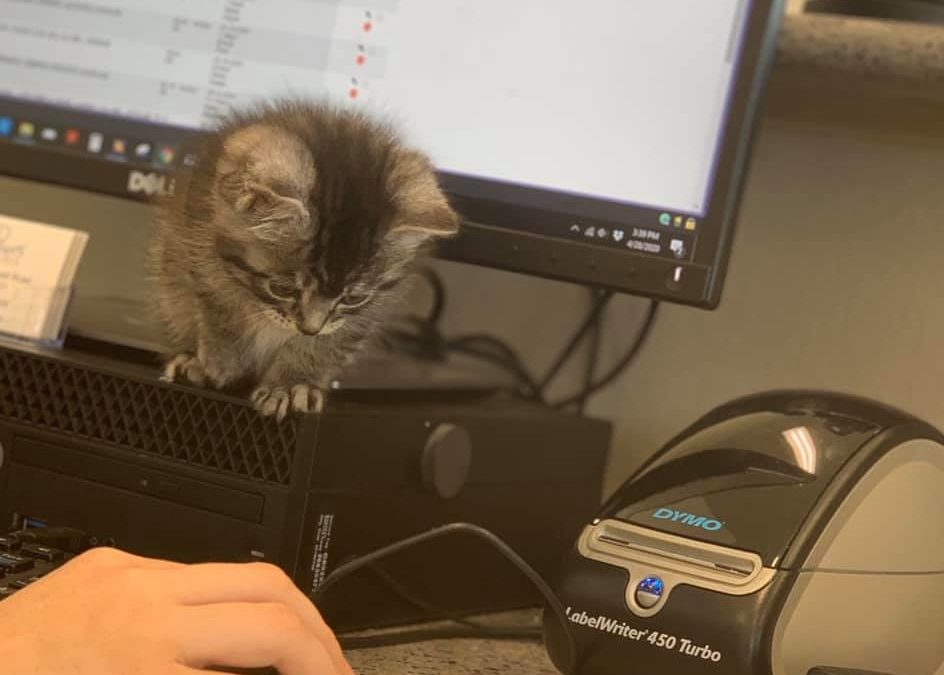Feline distemper is a viral condition that attacks rapidly dividing cells in the body including the bone marrow, intestinal tract, and skin. While distemper is the common term for the disease in cats, this is actually a misnomer since the feline virus is structurally more similar to canine parvovirus than the distemper virus. The correct medical term for this condition is feline panleukopenia, which essentially translates to, “low levels of all white blood cells.” Fortunately, panleukopenia is now largely uncommon, although it used to be a leading cause of death in cats. Despite its infrequency, knowing about this disease—and the importance of its vaccine—is valuable. Here’s what pet owners need to know about feline distemper/panleukopenia:
1. Cat distemper is highly contagious.
The virus that causes feline panleukopenia is shed in the urine, stool, blood, and nasal discharge of infected cats. When a susceptible cat comes in contact with these secretions, the virus can be transmitted. Not surprisingly, distemper can spread rampantly in situations where unvaccinated cats are housed together such as in shelters, pet shops, or feral cat colonies. Kittens may even be exposed in utero or through breast milk if the mother is infected during pregnancy or while nursing. Even though direct contact with an infected animal is the most common route of transmission, the feline distemper virus can miraculously survive on surfaces for up to one year. Completely eliminating the virus from the environment is essentially impossible, making it one of the most robust and contagious feline viruses. This means that clothing, food bowls, bedding, and even people can be vectors of virus transmission. Safe cat handling and proper disinfection are crucially important in the control of feline distemper.
2. Some cats are more vulnerable to feline distemper.
Since the virus that causes feline panleukopenia is so hearty in the environment, it is virtually everywhere. Nearly all cats are exposed to the virus at some point in their life, but a select few are at risk for serious illness. Healthy, vaccinated adult cats are unlikely to become ill, but providing safe housing and practicing good hygiene will help keep these pets disease-free. Young, unvaccinated kittens are most susceptible to the effects of feline distemper, along with sick, pregnant, or immunocompromised cats. Because their immune systems are not fully developed or able to fight off infection, vulnerable cats often become quite sick, with most requiring temporary hospitalization. Feline distemper is most common in kittens 3 to 5 months of age. In general, younger kittens and those that contract the virus in utero carry a poorer prognosis for recovery.
3. The symptoms of distemper in cats can mimic other diseases.
A cat sick with distemper may have a fever, appear lethargic, or have a decreased appetite. They may also exhibit vomiting, diarrhea, weight loss, dehydration, or a combination of any of the above signs. In general, the clinical signs associated with distemper are considered non-specific, in that they are commonly seen with many other conditions. Therefore, running additional diagnostics is recommended in order to diagnose and treat this devastating disease. Routine laboratory work may show a blood count with low levels of red and white blood cells—a good indicator of panleukopenia infection. A special fecal test can also diagnose feline distemper, but false positives can occur if the cat was recently vaccinated. Veterinarians rely on knowing the patient’s history (where the cat came from, what it’s housing situation was like, etc.), examination findings, and blood tests for accurate diagnosis and treatment.
4. Treating feline distemper can be difficult.
Because panleukopenia is a viral disease and no antiviral medication exists for it, treatment is typically supportive and often requires hospitalization. The main concern with feline distemper is the virus’s ability to attack the bone marrow, which can severely reduce the number of a patient’s blood cells and, subsequently, their ability to fight off infections. This becomes a problem not only in combatting the virus, but also any secondary infections that may occur as a result of a compromised immune system. Most affected cats will require intravenous fluids to correct dehydration, nutritional support, medications to cope with symptoms and other infections, and consistent monitoring. Supportive care is paramount in treating feline distemper—without it, as many as 90% of affected cats will not survive.
5. Preventing feline distemper is relatively simple.
While no preventive measure is 100% effective, certain veterinary advancements have made this once prevalent virus an uncommon concern today. Thanks to the feline panleukopenia vaccine and a safe and effective vaccination schedule, kittens and adult cats can reap the protective benefits—and their owners can rest a bit easier. Of course, since the virus can withstand harsh temperatures and environments, timely vaccination and good hygiene are cornerstones of preventing feline distemper transmission. Kittens should receive their first vaccine between 6 and 8 weeks of age, with additional (booster) vaccinations every 3 to 4 weeks until 16 weeks. Failure to adhere to the recommended schedule may result in incomplete immunity and susceptibility to infection. If your cat contracts feline panleukopenia, follow your veterinarian’s guidance on proper at-home care and monitoring, especially if you share your home with other cats. Fortunately, cats that survive a distemper infection will likely retain lifelong immunity.

